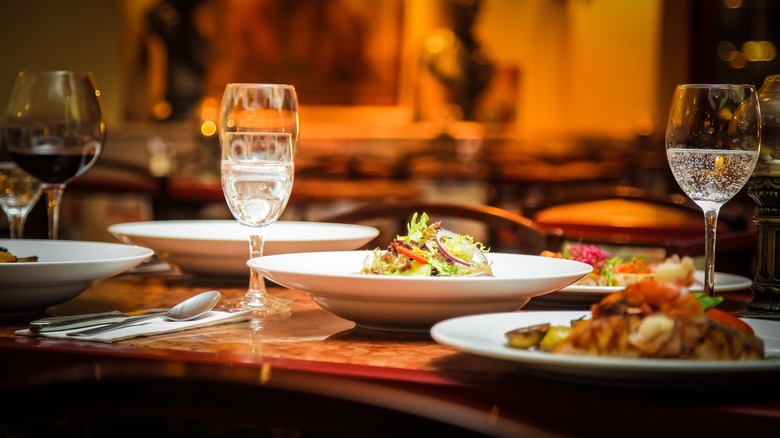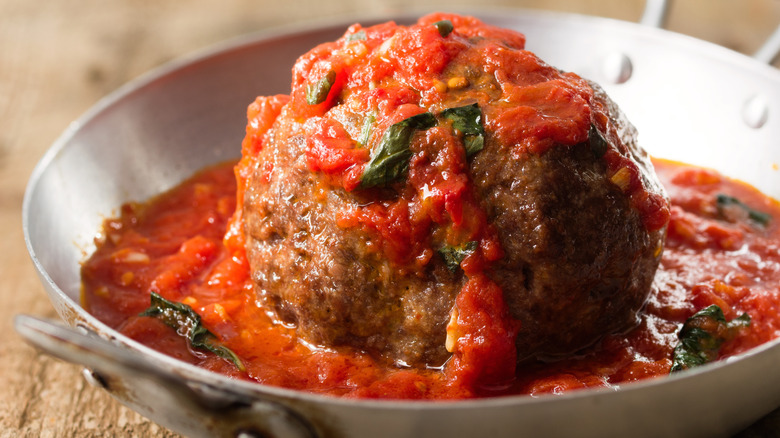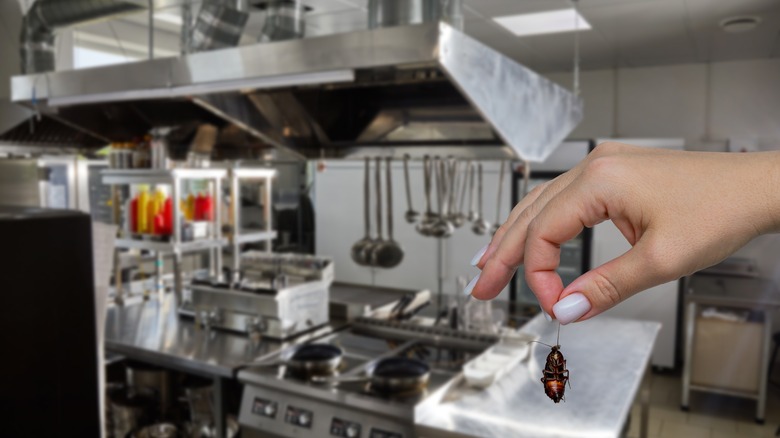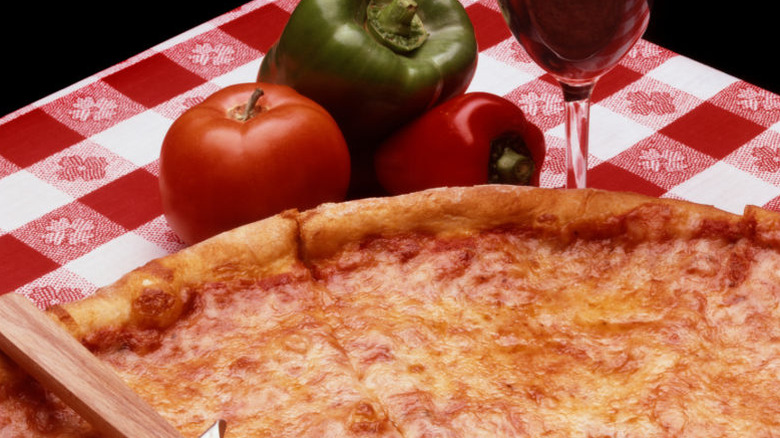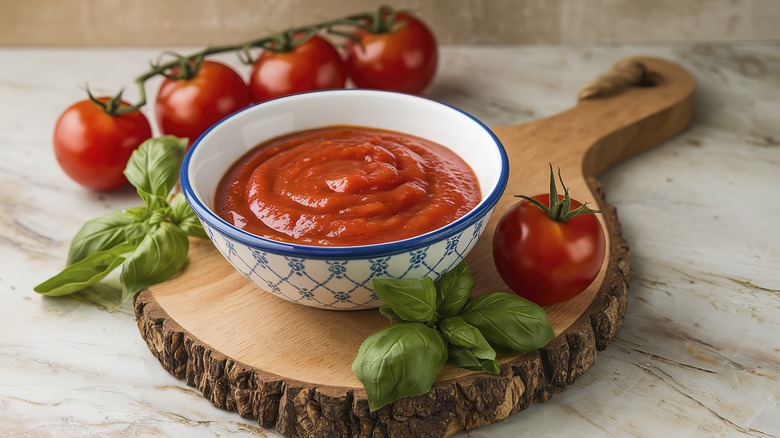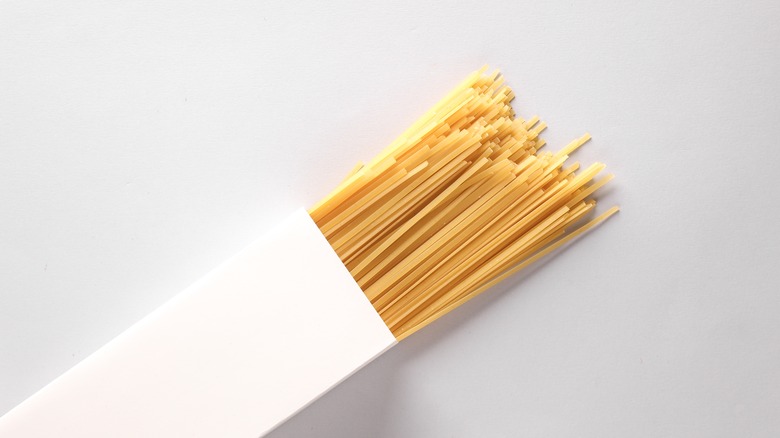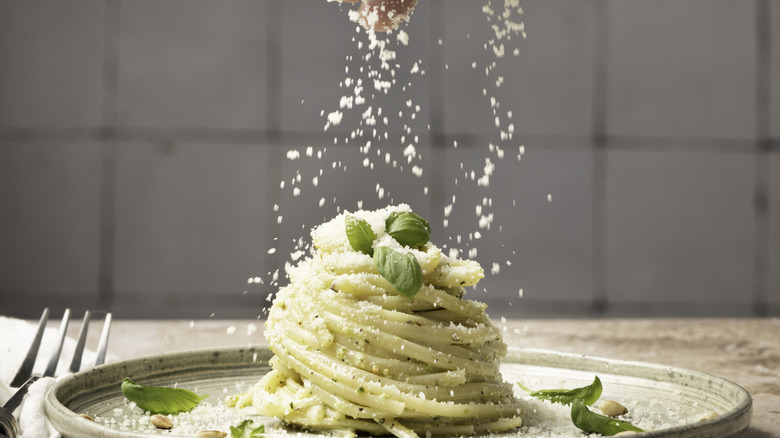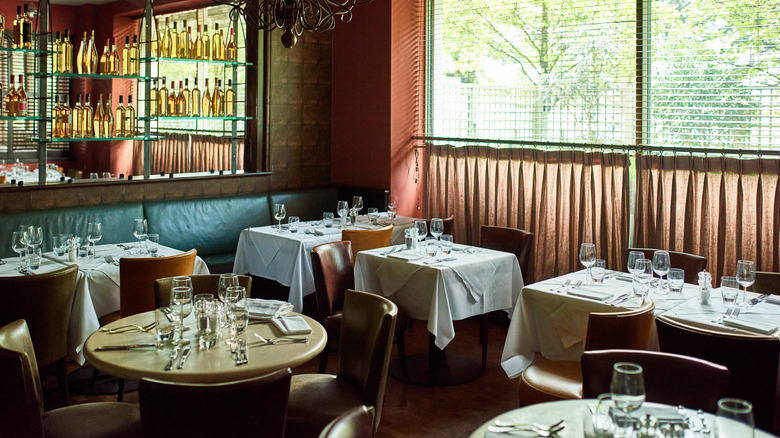12 Red Flags That Will Have You Running From An Italian Restaurant
There is nothing better than a genuine Italian dining experience. Perfectly cooked pasta, artfully crafted sauces, and wine that's been hand-selected for your meal can make for the perfect night out. You want to be treated to a beautifully curated experience, which includes knowledgeable and friendly service staff to match. But if you've put in the effort to plan a nice meal, you want the spot to deliver — and not every restaurant that calls itself "authentic Italian" is the real deal.
There are imposters out there, duping you with overpriced food, cheap or frozen ingredients, and a menu that's been the same since the place opened its doors. These places cut corners in both ambiance and quality, posing as a "real" Italian spot. There are lots of things to look out for when seeking a true Italian dining experience. And there are some red flags that just might have you running from one.
Servers are clueless about the food
In a good Italian restaurant, your server should be a connoisseur of the food and wine just as the chef is. They should be able to explain exactly what any given dish contains, how it was prepared, and offer suggestions for wine pairings that will fit perfectly with the food. This is not only a mark of authenticity, but is a safety concern as well. It's a big red flag if your server is fuzzy on which ingredients are used in any particular dish, it could be a hazard to those with allergies or food aversions.
An authentic experience comes from each employee knowing their role down to every detail, and being able to adequately pass that knowledge to their customers. If you're in a place where the waiter staff seem confused or don't have knowledge of the menu, it likely means they haven't studied their food and haven't even sampled what they offer. If that's your experience, you might want to leave the restaurant before ordering.
Giant meatballs
The meatball is a dish that has been severely Americanized. These fist sized chunks of meat may be popular in your local Olive Garden, but are foreign to authentic Italian places. In many lesser Italian bistros in the United States, it has become popular to serve gargantuan meatballs over a bed of pasta. This is not authentic; meatballs in Italy (called polpette) are often very small, about the size of golf balls. They're also often served on their own, instead of heaped atop a pile of pasta. Spaghetti and meatballs as we know it is actually more of an American invention than an Italian one, which is why it may be harder to find if you venture to a truly authentic restaurant. There are many ways to make a meatball, but only one way to make a genuine Italian meatball.
These beefy giants are not a true stroke of Italian cuisine and are often packed with fillers like breadcrumbs or cheese. If you're served one of these mega meatballs doused in sauce, the restaurant is probably prioritizing novelty and portion size over quality of ingredients and authenticity. At that point, it may be too late to run, but think twice before returning a second time.
Signs of Uncleanliness
This should be a red flag in any restaurant you attend, not just the Italian ones. A clean, well-kept space is the bare minimum for a dining experience. If you're noticing that the restaurant is dirty or notice any smells other than delicious Italian food, it's time to run for the hills. Dirty floors, sticky or greasy tables, and signs of debris in any area of the establishment is a huge marker to get out as quickly as you arrived. Successful restaurant owners take pride in not only their food, but the overall ambience and atmosphere that their diners will be enjoying. A thoughtful and attentive owner will make sure your dinner is enjoyable from the moment you step into the restaurant.
If the front of the house is messy, can you imagine what's going on in the kitchen? Cleanliness is not only important for customer retention, but also crucial for food safety practices. Unsavory sights and smells can be a sign of health hazards and potentially unsafe practices when preparing food.
Cheap decor
When you enter any Italian eatery, you'll notice a difference between charming, homey decor, and decor that is flat-out cheap. There are some tell-tale markers of classic Italian decor, such as the trademark red and white checked tablecloth. However, if you're dining somewhere where this iconic piece is made out of cheap plastic instead of real linen, it could be a sign that frugality will show up in other places, like the menu. Other fixtures such as murals and rustic decorations can really make a difference depending on if they're clearly items that have meaning and value, versus mass-produced decor that came from a big box store.
People love the atmosphere of Italian restaurants because they feel comforting, kind of like home. You should feel like you're walking into someone's kitchen, not a five and dime shop. If you scan the environment and everything looks like a cheap imitation of the real thing, this could be a bad sign for your dining experience.
No seasonal dishes
A menu that changes depending on the season shows the chef's dedication to using ingredients that are at their freshest. A chef who is proud to provide diners with dishes at their peak of flavor requires the use of seasonal ingredients, and changing their menu to reflect that. If you notice squash-heavy dishes in the fall and dishes featuring tomatoes in summer, this is a good sign. However, menus that don't go through any changes mean the chef is probably relying on frozen ingredients, which are lacking in both nutrition and flavor. Additionally, true chefs take pride in their creativity and ability to put their own personal touches on favorites. If a restaurant never switches it up, the menu can grow stale.
The use of seasonal ingredients shows diners that a restaurant takes advantage of fresh produce, and may even support local farms and small businesses. If a restaurant's menu has been the same throughout the seasons — and even for many years — there is no ingenuity or originality. Don't make the assumption that there are no healthy choices, and look for spots that have fresh, seasonal items that utilize real produce and whole ingredients.
They offer non-Italian food
Italians are extremely proud of the cuisine they offer in their restaurants. If you're dining at a so-called Italian joint and you see things like burgers on the menu, it's clear the vision isn't strictly Italian, and they're probably not confident in the food they're serving, so they feel the need to overcompensate with several kinds of dishes. There is a huge difference between offering some kid-friendly options and perhaps a non-traditional pasta dish — then there's diluting the menu with options that could never be considered Italian food.
A great Italian menu will be populated with regional dishes in all courses, like antipasti, pastas, and desserts. Having some lukewarm Americanized Italian dishes as well as an abundance of pub food or salads shows a flaky commitment to authenticity. The authentic Italian restaurants — the ones you shouldn't run from — are concerned with providing high-quality and delicious true Italian cuisine.
Weak wine list
A good Italian restaurant will have a wine list that boasts a variety of well-aged and well-selected wines that complement the specific dishes they offer. This carefully curated list is a key pillar of any reputable Italian spot. Italy is one of the most diverse and celebrated wine producing countries in the world, and a solid wine list will reflect many regions and types of wine. If you see wines that run cheaper, or wines that aren't predominantly Italian, it's a good sign the restaurant picked for price and not for flavor palette.
Also, if you feel like there was no real thought put into the list — for example, there aren't carefully planned pairings or the servers seem uneducated about which wine would go best with the pasta or other main you've selected — this indicates the wine was more of an afterthought than treated as an important part of the dining experience. In Italy, wine is much more than just a beverage — and it can be a crucial part of a meal that brings it all together.
They only serve boxed pasta
Pasta right from the box can hit the spot if you're a home cook, especially for quick and easy weeknight meals. But if you're dining out and seeking a true, authentic Italian meal, homemade pasta is what you're after. Homemade pasta adds richness, enhances texture, and builds on flavor in Italian dishes. The mouthfeel of the pasta can change the whole dynamic of a main course, and the quick cooking time and makeup of the pasta mean it soaks up sauce differently than pasta from a box.
This isn't the reddest of red flags; after all, many reputable Italian restaurants in the United States don't use freshly made pasta and still serve delicious meals. However, it's that one extra touch that really sells authenticity and dedication to the dish. Making pasta yourself is fairly simple, and even though boxed pasta gets the job done, if you're looking for real authenticity, seek out Italian establishments that take the time to make their own pasta.
Powdered cheese from a canister
Another of the reddest red flags is the dreaded powdered parmesan. Nothing can kill a good meal like a clumpy, pre-packaged parm sitting in a shaker on your table when you arrive. True Italian cuisine will feature fresh Parmesan, usually grated right at your table in any amount your heart desires. If a place is cutting corners on their cheese, it can raise concerns about what else they're skimping on. Cheap packaged cheese can point to pre-packaged sauce, low quality olive oil, and countless other low-cost alternatives to quality products. While this one detail doesn't make or break an establishment, it's a good hint to be on the lookout for other ways they might be cutting corners.
A genuine Italian chef would never use powdered cheese that usually contain oils and cellulose powder, and are packed with anti-caking agents that prolong the shelf life but destroy flavor. Good chefs care about the meal down to the last detail, and these small finishing touches are what complete a fine Italian dining experience.
Jarred sauces
Just like boxed pasta, while jarred sauces may be convenient at home, they are a definite red flag when dining out. Some taste buds may be indiscriminate, but those who eat a lot of pasta sauce can generally tell whether it's homemade or not. Homemade sauce tastes rich and complex, while jarred sauces are flat and tinny. Homemade sauce will use fresh, seasonal ingredients, and even a layman can taste the difference if you were to compare the two. Some of the jarred sauces used may even be frozen, which is another way the sauce can lose more flavor, and can open the dish up to health risks when thawing.
The main component to keep in mind with homemade sauces is the time that goes into them. House-made marinara will often be simmered for a long time, with the chef carefully balancing the tomato with herbs and other ingredients to create the perfect accompaniment to pasta. You may think you can craft the perfect pasta sauce at home, but an Italian spot is the place to find the good stuff. If you locate a restaurant that uses exclusively jarred red sauce or alfredo, it's likely the chef hasn't been properly trained — and that might be a sign to turn around and exit.
Empty dining area
A good, popular Italian joint will be mostly full during hours of operation. This may include a lunch rush and bustling dinner scene — and they may even require reservations. If you can waltz in at any time and notice that you're one of the only diners, this may be an indicator that locals know to avoid the place. Part of the ambience that Italian restaurateurs strive for is a full dining room heavy with conversation and sounds of food being enjoyed. If that's missing, there's probably a good reason why.
A popular restaurant will attract not only locals, but tourists from word of mouth and positive online reviews. In the age of modern technology, if a restaurant is starkly empty, it's likely because people in the area know something you don't. Listen to your intuition: Is it just a slow time of day during a slow time of the year? Or is it possible the locals know to run in the other direction from this spot?
Photo-heavy menus
In traditionally Italian eateries, the menus are often simple, minimalistic, and thoughtful. Sometimes these are even handwritten to reflect that the menu changes often with the seasons. A laminated packet that is crowded with photographs of the dishes being served is a sign of an overly-Americanized menu. Authentic Italian-style restaurants usually won't have these photos, and the dishes will be written in Italian with English explanations. Photo-centric menus are good indicators the food may be mass produced, or that you might be eating at a chain restaurant. Often the food that comes to the table looks nowhere near as perfect as the image you were provided, which can be disappointing.
The focus of a real Italian menu will be the quality of the ingredients, the preparation of the dishes, and explanations of flavors or wine pairings. The restaurant is not as concerned about marketing or providing picture-perfect versions of dishes to diners, because the flavors will speak for themselves.

